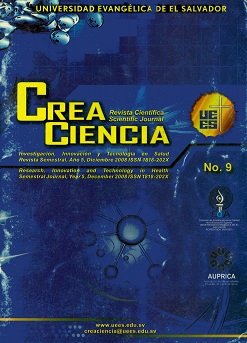"Takotsubo" cardiomyopathy
DOI:
https://doi.org/10.5377/creaciencia.v0i9.8211Keywords:
Takotsubo cardiomyopathy, cardiac syndromeAbstract
Takotsubo cardiomyopathy is a cardiac syndrome recently reported in hp& by Sato (1990), characterized by transient left ventricular dysfunction, oppressive precordial pain, ischemic-type electrocardiographic changes, slight or no release of myocardial necrosis markers, simulating an acute infarction. of myocardium (1,2). This syndrome usually occurs after severe physical or emotional stress, and is observed predominantly in females. Prior to the report of this syndrome, it had been reported in the world medical literature that situations that caused great physical stress (major surgeries, serious injuries to the central nervous system) or emotional stress were capable of producing del. Severe in the heart, including acute failure of its systolic function (3, 4, 5, 6, 7, 8, 9, 10, 11, 12, 13). As the first cases of "takotsubo" were reported in Japan (14, 15, 16), it was initially believed that there could be a genetic component in its cause, related to the oriental ethnic group. Shortly after the first Japanese series were published, other countries such as Spain, Belgium, Australia and the United States published their first cases (17, 18, 19, 20, 21, 22). These latest reports ruled out that it was a clinical entity related to a particular race. The Japanese word takotsubo, is composed of tako, which means octopus and tsubo, bottle (1, 2, 6). This is an artifact designed to catch such molluscs: the animal easily penetrates it but can no longer get out (Fig. 1 and 2). In Japanese gastronomy, octopus is a highly appreciated food and takotsubo is frequently used in the homes of Japanese fishermen as an ornament in their interior decoration. Takotsubo cardiomyopathy has been known by other names: stress cardiomyopathy (4, 9, 10), broken heart syndrome (7), transient left ventricular apical engulfment (13,14), and transient left ventricular apical akinesia syndrome ( 17, 18, 19). Some evoke the severe but transitory component of physical or emotional stress in the genesis of the syndrome, determining its relative duration and full clinical recovery in most patients.
Downloads
Published
Issue
Section
License

This work is licensed under a Creative Commons Attribution-NoDerivatives 4.0 International License.
Los artículos de Crea Ciencia están publicados en acceso abierto bajo una licencia CC BY-NC-SA 4.0 de la Universidad Evangélica de El Salvador.





















